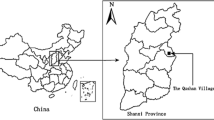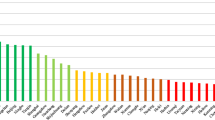Abstract
How to solve the contradiction between development needs and environmental protection has become the difficulty and focus of rural grass-roots government governance. In this paper, from the two dimensions of information interaction and energy flow, based on the calculation of environmental value-added, a new rural environment environmental value-added model is established, and the reliability of the model is verified by taking the data of Pingding County in Shanxi Province as an example. The results show that: (1) the accuracy of the information flow environmental value-added model is as high as 95.96%, and the model can be applied to the outdoor environment comfort prediction; (2) the comprehensive index of the relative value-added of the ecological environment is reduced from 0.61 to 0.31, and the value-added situation of the ecological environment is negative in the evaluation period, and the development is unbalanced and unsustainable. The trend of continuous development is in line with the actual local development. By measuring the relationship between the gain effect and the cost input of the ecosystem, the model comprehensively analyzes the potential of land and space development and protection in the future, and provides basic support for improving the strategy of main functional areas, drawing up land spatial planning, scientifically delimiting ecological protection red line, permanent basic farmland and urban development boundary, and exercising unified land space use control and ecological protection and restoration, try to open up a new situation of environment and development







Similar content being viewed by others
Change history
16 September 2021
A Correction to this paper has been published: https://doi.org/10.1007/s10668-021-01762-w
References
Ali, M., Marvuglia, A., & Geng, Y. (2019). Accounting emergy-based sustainability of crops production in India and Pakistan over first decade of the 21st century. Journal of Cleaner Production, 207, 111–122.
Amaral, L. P., Martins, N., & Gouveia, J. B. (2016). A review of emergy theory, its application and latest developments. Renewable and Sustainable Energy Reviews, 54, 882–888.
Babcicky, P. (2013). Rethinking the foundations of sustainability measurement, the limitations of the environmental sustainability index (ESI). Social Indicators Research, 113(1), 133–157.
Bagstad, K. J., Semmens, D. J., Waage, S., & Winthrop, R. (2013). A comparative assessment of decision-support tools for ecosystem services quantification and valuation. Ecosystem Services, 5, 27–39.
Chang, T., Yang, D., Huo, J., Xia, F., & Zhang, Z. (2018). Evaluation of oasis sustainability based on emergy and decomposition analysis. Sustainability-Basel, 10(6), 1856.
Changqing, S. (2016). On paradigms of geographical research. Progress in Geography, 35(1), 1–3.
Cheng, C. X., Shi, P. J., Song, C. Q., & Gao, J. B. (2018). Geographic big-data: A new opportunity for geography gomplexity study. Acta Geographica Sinica, 73(8), 1397–1406.
Cheng, C., & Cheng, K. (2018). Evaluation of the sustainability of Hakka villages in the Lui-Tui area of Taiwan via emergy analysis. Environment, Development and Sustainability, 20(6), 2831–2856.
Cheng, Z., & Zuyun, L. (2018). From “fragmentation” to “integrity”: The realistic path of rural environmental governance. Jianghuai Forum, 3, 28–33.
Dadashpoor, H., Azizi, P., & Moghadasi, M. (2019). Land use change, urbanization, and change in landscape pattern in a metropolitan area. Science of The Total Environment, 655, 707–719.
Fan, Y., Qi, Q., Xian, C., Xiao, Y., & Fang, L. (2017). A modified ecological footprint method to evaluate environmental impacts of industrial parks. Resources Conservation & Recycling, 125, 293–299.
Feiwei, S. (2019). Investigation on the realization path of rural environmental participatory governance: A case study of Digang village in Northern Zhejiang province. Agricultural Economic Issues, 8, 30–39.
Feiwei, S., & Zuyun, L. (2016). Logical remolding of good governance of rural environment: An analysis based on stakeholder theory. China Population, Resources and Environment, 26(5), 32–38.
Ferraro, D. O., & Benzi, P. (2015). A long-term sustainability assessment of an Argentinian agricultural system based on emergy synthesis. Ecological Modelling, 306(6), 121–129.
Graymore, M. L. M., Sipe, N. G., & Rickson, R. E. (2010). Sustaining human carrying capacity, a tool for regional sustainability assessment. Ecological Economics, 69(3), 459–468.
Greenberg, P. (2017). Disproportionality and resource-based environmental inequality, an analysis of neighborhood proximity to coal impoundments in Appalachia. Rural Sociology, 82(1), 149–178.
Guan, X., Chen, M., & Hu, C. (2015). An ecological compensation standard based on emergy theory for the Xiao Honghe river basin. Water Science and Technology, 71(10), 1463–1470.
Haiyan, Z. (2017). Comprehensive evaluation of ecological civilization construction based on big data: A case study of Hainan province, an ecological civilization demonstration area. Land and Natural Resources Research, 4, 40–44.
Hongchun, Z., & Xi, Ji. (2009). Evolution of China’s environmental protection policy in the past 30 years of reform and opening up. Journal of Nanjing University, 45(1), 31–40. Social Science Edition.
Hui, H. (2017). Research on performance improvement of ecological civilization construction of local government driven by big data. Journal of Hunan University of Administration, 1, 5–9.
Ilieva, R. T., & McPhearson, T. (2018). Social-media data for urban sustainability. Nature Sustainability, 1, 553–565.
Jafari, M., Asgharipour, M. R., Ramroudi, M., Galavi, M., & Hadarbadi, G. (2018). Sustainability assessment of date and pistachio agricultural systems using energy, emergy and economic approaches. Journal of Cleaner Production, 193, 642–651.
Lacarrière, B., Deutz, K. R., Jamali-Zghal, N., & Le, C. O. (2015). Emergy assessment of the benefits of closed-loop recycling accounting for material losses. Ecological Modelling, 315, 77–87.
Li, Y. U., Yanyu, L. U., Wei, H., & Yuqing, X. U. (2016). The significance and general approaches of climatic carrying capacity assessment. Chinese Journal of Urban and Environmental Studies, 04(01), 1650005.
Liqiong, W., & Yunfeng, Z. (2019). Study on the effective path of multiple co governance of rural environment in Quanzhou from the perspective of rural revitalization. China Agricultural Resources and Regionalization, 40(8), 219–225.
Liu, C., Shi, X., Qu, L., & Li, B. (2016). Comparative analysis for the urban metabolic differences of two types of cities in the resource-dependent region based on emergy theory. Sustainability-Basel, 8(7), 635.
Lu, D. (2017). Research on Wuxi ecosystem health assessment based on emergy analysis. Nanjing University.
Luo, F., & Jing, Z. L. (2019). Evolutionary game study on multi-agent collaborative governance of rural ecological environment. Ecological Economy, 35(10), 171–176.
Mainali, B., Pachauri, S., Rao, N. D., & Silveira, S. (2014). Assessing rural energy sustainability in developing countries. Energy for Sustainable Development, 19(1), 15–28.
Martí, P., Serrano-Estrada, L., & Nolasco-Cirugeda, A. (2019). Social media data: Challenges, opportunities and limitations in urban studies. Computers, Environment and Urban Systems, 74, 161–174.
Mei et al. (2014). Research on the current situation of rural environmental pollution and prevention and control measures. Zhejiang University.
Minjun, S. (2019). Rural environmental governance: Challenges and hopes. Environmental Economic Research, 2, 1–9.
Min, J. (2016). Changes of rural environmental governance since reform and opening up reform. (3), 84–93.
Mori, K., & Christodoulou, A. (2012). Review of sustainability indices and indicators, towards a new city sustainability index (CSI). Environmental Impact Assessment Review, 32(1), 94–106.
Odum, H. T. (1996). Environmental accounting–emergy and environmental decision making. Child Development, 42(4), 1187–1201.
Pang, M., Zhang, L., Ulgiati, S., & Wang, C. (2015). Ecological impacts of small hydropower in China, Insights from an emergy analysis of a case plant. Energy Policy, 76, 112–122.
Qingkui, L., Qinghua, Y., & Jing, Z. (2019). Study on rural human settlements and community participation. Journal of Southwest Forestry University, 6, 70–74.
Qiufeng, G., Qiran, Z., & Renfu, L. (2017). Analysis on the targeting and effectiveness of investment decision-making of rural environmental governance projects–evidence from rural areas of five provinces. Labor Economy Research, 5(4), 128–144.
Ruckelshaus, M., Mckenzie, E., Tallis, H., Guerry, A., Daily, G., Kareiva, P., Polasky, S., Ricketts, T., Bhagabati, N., Wood, S. A., & Bernhardt, J. (2015). Notes from the field, lessons learned from using ecosystem service approaches to inform real-world decisions. Ecological Economics, 115, 11–21.
Shu, L. S., & Rui, C. (2012). Analysis of key problems in rural environmental governance. Ecological Economy, 28(6), 185–187.
Siche, J. R., Agostinho, F., Ortega, E., & Romeiro, A. (2008). Sustainability of nations by indices, comparative study between environmental sustainability index, ecological footprint and the emergy performance indices. Ecological Economics, 66(4), 628–637.
Juan, T., Hong, G., & Qiong, T. (2018). Path innovation of government environmental governance in the era of big data. China Environmental Management, 10(1), 62–66.
Pei, T., Liu, Y. X., Guo, S. H., Shu, H., Du, Y. Y., & Ma, T. (2019). Principle of big geodata mining. Acta Geographica Sinica, 74(3), 586–598.
Wang, R. (2016). Construction and empirical study on evaluation index system of provincial ecological civilization in China. China University of Geosciences.
Yang, X. (2016). Research on the development model of resource-based rural transformation. Shanxi Agricultural University.
Yanqiang, D. (2019). Effectiveness, problems and countermeasures of rural environmental governance under PPP mode. Environment and Sustainable Development, 44(5), 69–72.
Yi, H., Srinivasan, R. S., Braham, W. W., & Tilley, D. R. (2017). An ecological understanding of net-zero energy building: Evaluation of sustainability based on emergy theory. Journal of Cleaner Production, 143, 654–671.
Yue, J., Jiang, X., Yuan, X., Wang, X., Li, B., & Liu, S. (2017). Design of a multiplexed system for domestic wastewater of happy farmer’s home (HFH) and environmental evaluation using the emergy analysis. Journal of Cleaner Production, 156, 729–740.
Zhou, M. M. (2011). Environmental injustice in China’s industrialized rural areas, observations from Juancheng county and their national context. Berkeley Undergraduate Journal, 24(3), 149–159.
Zishu, G. (2019). Significance, problems and countermeasures of rural ecological environment construction under the background of ecological civilization construction. Agricultural Economy, 2019(7), 33–34.
Zulaica, L., & Tomadoni, M. (2015). Environmental sustainability indicators in the periurban of Mar del Plata City, Argentina. Anales de Geografa de la Universidad Complutense, 35(2), 195–216.
Acknowledgements
Thanks to Pingding County Government for providing us with relevant data support.
Author information
Authors and Affiliations
Corresponding author
Additional information
Publisher's Note
Springer Nature remains neutral with regard to jurisdictional claims in published maps and institutional affiliations.
Rights and permissions
About this article
Cite this article
Wan, A., Qi , X., Yue, W. et al. Construction and case verification of rural environmental value-added evaluation system. Environ Dev Sustain 24, 1781–1797 (2022). https://doi.org/10.1007/s10668-021-01508-8
Received:
Accepted:
Published:
Issue Date:
DOI: https://doi.org/10.1007/s10668-021-01508-8




